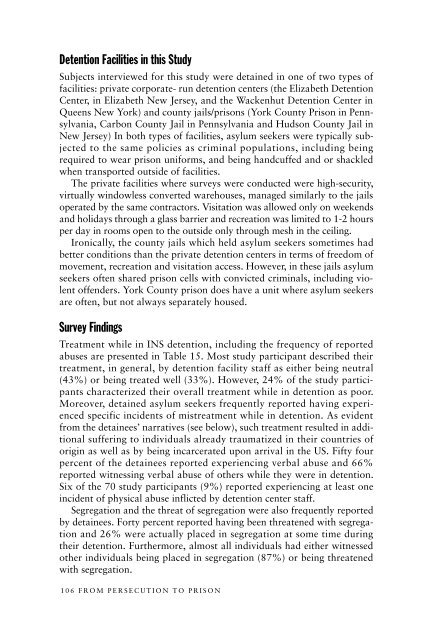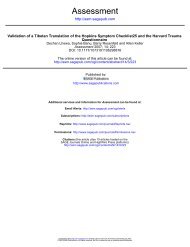From Persecution to Prison - Bellevue/NYU Program for Survivors of ...
From Persecution to Prison - Bellevue/NYU Program for Survivors of ...
From Persecution to Prison - Bellevue/NYU Program for Survivors of ...
You also want an ePaper? Increase the reach of your titles
YUMPU automatically turns print PDFs into web optimized ePapers that Google loves.
Detention Facilities in this StudySubjects interviewed <strong>for</strong> this study were detained in one <strong>of</strong> two types <strong>of</strong>facilities: private corporate- run detention centers (the Elizabeth DetentionCenter, in Elizabeth New Jersey, and the Wackenhut Detention Center inQueens New York) and county jails/prisons (York County <strong>Prison</strong> in Pennsylvania,Carbon County Jail in Pennsylvania and Hudson County Jail inNew Jersey) In both types <strong>of</strong> facilities, asylum seekers were typically subjected<strong>to</strong> the same policies as criminal populations, including beingrequired <strong>to</strong> wear prison uni<strong>for</strong>ms, and being handcuffed and or shackledwhen transported outside <strong>of</strong> facilities.The private facilities where surveys were conducted were high-security,virtually windowless converted warehouses, managed similarly <strong>to</strong> the jailsoperated by the same contrac<strong>to</strong>rs. Visitation was allowed only on weekendsand holidays through a glass barrier and recreation was limited <strong>to</strong> 1-2 hoursper day in rooms open <strong>to</strong> the outside only through mesh in the ceiling.Ironically, the county jails which held asylum seekers sometimes hadbetter conditions than the private detention centers in terms <strong>of</strong> freedom <strong>of</strong>movement, recreation and visitation access. However, in these jails asylumseekers <strong>of</strong>ten shared prison cells with convicted criminals, including violen<strong>to</strong>ffenders. York County prison does have a unit where asylum seekersare <strong>of</strong>ten, but not always separately housed.Survey FindingsTreatment while in INS detention, including the frequency <strong>of</strong> reportedabuses are presented in Table 15. Most study participant described theirtreatment, in general, by detention facility staff as either being neutral(43%) or being treated well (33%). However, 24% <strong>of</strong> the study participantscharacterized their overall treatment while in detention as poor.Moreover, detained asylum seekers frequently reported having experiencedspecific incidents <strong>of</strong> mistreatment while in detention. As evidentfrom the detainees’ narratives (see below), such treatment resulted in additionalsuffering <strong>to</strong> individuals already traumatized in their countries o<strong>for</strong>igin as well as by being incarcerated upon arrival in the US. Fifty fourpercent <strong>of</strong> the detainees reported experiencing verbal abuse and 66%reported witnessing verbal abuse <strong>of</strong> others while they were in detention.Six <strong>of</strong> the 70 study participants (9%) reported experiencing at least oneincident <strong>of</strong> physical abuse inflicted by detention center staff.Segregation and the threat <strong>of</strong> segregation were also frequently reportedby detainees. Forty percent reported having been threatened with segregationand 26% were actually placed in segregation at some time duringtheir detention. Furthermore, almost all individuals had either witnessedother individuals being placed in segregation (87%) or being threatenedwith segregation.106 FROM PERSECUTION TO PRISON



